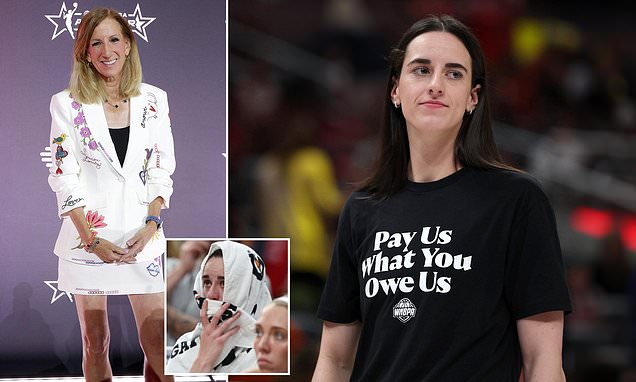It started with a T-shirt.
WNBA commissioner Cathy Engelbert was on a golf course near Lake Tahoe when she noticed someone sporting Golden State Valkyries gear — a team that’s barely halfway through its debut season.
For Engelbert, it wasn’t just casual fanwear.
It was a symbol of the league’s surging popularity and a clear sign that something big is brewing in women’s basketball.
Golden State might be the new kids on the block, but projections say they’re on track to surpass even the New York Liberty in value by next year.
That’s $400 million we’re talking about — and counting.
Engelbert calls it “hyper growth,” a term that now fits the WNBA’s explosion in popularity, revenue, and viewership since stars like Caitlin Clark and Angel Reese burst onto the scene.
The Stars Are Here, But So Are the Storm Clouds
With rising attention comes higher stakes.
During All-Star weekend in Indianapolis, the spotlight turned serious when Caitlin Clark and fellow players silently protested by wearing black shirts that read: “Pay Us What You Owe Us.”
The statement was loud despite the silence — and social media took it and ran.
Fans chanted “Pay them! Pay them!” at Engelbert, who was momentarily cast as the villain.
But despite the tension, she remains hopeful.
A new collective bargaining agreement is on the horizon, and Engelbert says it could be “transformational.”
“We’ve been building toward this moment,” she says.
“And Caitlin’s been a phenomenal part of it.”
From Game-Changer to Controversy Magnet
Since being drafted first overall by the Indiana Fever in 2024, Clark has become a headline magnet.
But with the fame has come friction.
She’s been on the receiving end of hard hits, online criticism, and even accusations of being a target on the court — not just because she’s a star, but possibly because of who she is.
Her rookie year saw a fierce bump from Chennedy Carter that sent the internet into a frenzy.
Then came a fiery opening-night showdown with Angel Reese.
Most recently, she took another hard hit against the Connecticut Sun.
Teammate Sophie Cunningham often plays the role of protector, but even she couldn’t shield Clark from jabs — like the one Kelsey Plum seemed to aim at her after the protest.
The speculation grew louder: Is Clark being bullied?
Is jealousy driving it?
Or does race play a role?
Clark herself has acknowledged her privilege as a white player.
It’s a difficult, divisive topic — and it won’t go away quietly.
Physical Play or Something Deeper?
Engelbert is careful not to fuel the fire.
When asked if she thinks Clark is treated unfairly, she sidesteps.
“It’s a physical game,” she says.
“And it’s not just Caitlin — everybody’s getting bumped out there.”
Still, the underlying tension is real.
Clark’s rise has exposed cultural rifts and stirred broader debates around race, gender, and representation.
The WNBA has become a battleground for more than just basketball.
When the Court Becomes a War Zone
Off the court, the hostility has taken a disturbing turn.
Twice in a week, WNBA games were interrupted by sex toys being thrown onto the court.
Online abuse, much of it misogynistic and racist, continues to flood players’ mentions.
Engelbert says the league is fighting back.
They’ve launched tech tools to help players filter out hate on social media and have issued warnings to unruly fans at arenas.
“There’s too much toxicity online,” she says.
“And unfortunately, it’s mostly aimed at women.”
Despite the hate, the league is thriving.
Merchandise sales broke records last season, attendance jumped nearly 50%, and TV ratings soared.
Fans Show Up — Now Players Want Their Cut
When Engelbert took over in 2019, the WNBA had around 80 nationally televised games.
That number has now climbed to more than 200.
But the league’s rapid success has renewed focus on a sore spot: pay.
Caitlin Clark’s rookie salary? Just $76,500.
In comparison, NBA rookie Victor Wembanyama raked in over $12 million.
The gap sparked outrage — even former President Joe Biden chimed in, calling for fair pay for women.
Clark, Engelbert notes, is thoughtful about the sport and its future.
“She’s not just thinking about her own game — she’s thinking about growing women’s basketball overall.”
But the commissioner wants to remind everyone: no league is built on a single player.
Not in the Larry Bird era, the Michael Jordan era, or now.
All Eyes on Clark… and Then She Sat Out
Despite all the controversy, All-Star weekend was meant to be Clark’s moment.
She’d earned the most fan votes, was named a team captain, and the game was scheduled in her home arena in Indiana.
Everything was lined up for a triumphant showcase.
Then came the groin injury.
Clark, who had never missed a game in her college or pro career, was sidelined.
That absence has now extended to 13 missed games this season.
And frustration is mounting — her brother even blamed referees in a now-deleted social media post for the physicality that might have contributed to her injury.
The League Needs Clark — But So Does the Future
Engelbert insists the WNBA isn’t too soft — or too hard. It’s just competitive.
“People think women shouldn’t be physical.
That’s the narrative we’re trying to change,” she says.
“Yes, Caitlin’s getting hit. But so is everyone else.”
Still, there’s no denying that a healthy Clark is vital.
Not just for Indiana Fever’s success, but for the league’s momentum.
She’s the face of a movement — but she can’t carry it alone.
Expanding the Court — And the Globe
The WNBA isn’t just building for now; it’s building for what’s next.
Expansion is already underway.
New teams in Cleveland, Detroit, and Philadelphia are on the way.
Toronto and Portland are set to join by 2026.
And Engelbert says the global stage is the next step.
“We’ve watched what the NBA has done.
We want to go international — Europe, the Middle East, Asia, and maybe even Africa in the future.”
But she knows what matters most.
“The product on the court is everything,” she says.
“And right now, we’re lucky.
We’ve got the best players in the world.”
So What’s Next?
The WNBA is having a moment — but not without its growing pains.
As the league balances explosive growth with deeper cultural challenges, one thing is clear: the spotlight is here to stay.
Caitlin Clark may be the face of the movement, but the WNBA’s strength will depend on how it supports all its players — and whether it can rise above the noise to deliver on its promise.
Because the world is watching.

